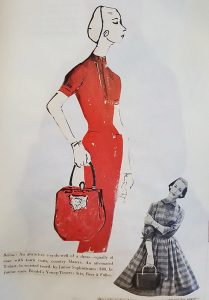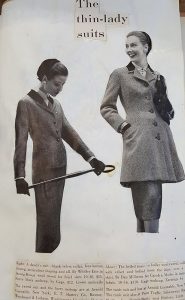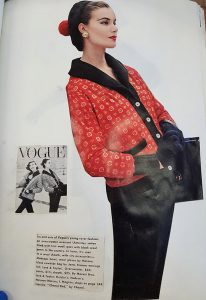Historic Scrapbook Collection, Culture and Gossip
Scrapbooks are an invaluable repository of cultural heritage. The collection here at the DeKalb History Center represents a range of years and subjects.
Written by DHC Intern Samantha Mooney
“My father used to say that stories are part of the most precious heritage of mankind.” ― Tahir Shah, In Arabian Nights: A Caravan of Moroccan Dreams
I love perusing through old scrapbooks. An unorthodox hobby, I know, but I find them utterly fascinating. This strange amusement supports commonly held assumptions: that historians and archivists are fundamentally nosy, digging through people’s mail and scrutinizing their written records. Personally, it as an extension of natural curiosity. Most of us are captivated by the past. If we know where we come from, we can forecast where we are headed.
Needless to say, I’ve had a great time poking around the DeKalb History Center’s collection of 100+ historic scrapbooks. Scrapbooks are an invaluable repository of cultural heritage. The collection here at the DeKalb History Center represents a range of years and subjects. Some are more plain, covering local community events such Decatur High Civation Club, a volunteer service organization, and the Glencrest Garden Club. Even these are interesting in their own way. The Civiation Club’s scrapbook is bound onto a wooden plank, featuring a hand-lettered title. The Glencrest Garden Club features glamorous women, bedecked in furs and jewels, winning prizes for grandiose, towering flower arrangements.
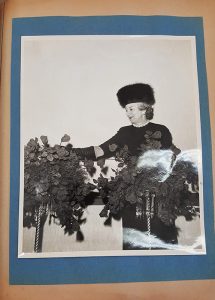

Some are much mysterious. George M. Everhart created a “sketch and fashion book” from 1955 to 1985. It covers the changes in fashion from the post-war era from the glamorous, voluptuous skirts to the sultry tailored dresses of the 1960’s. It is easy to imagine that this was a collection of fashion trends: it features clippings from Vogue and Harper’s Bazaar. Yet, we have not a clue what Everhart’s motivation was for making it. Was he documenting fashion trends? Was he an artist, seeking to establish references for clothes and figures? Or was he just interested? We don’t have any further information on the providence so we can only speculate.
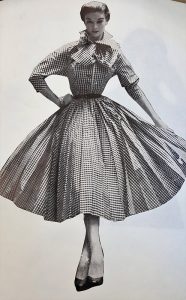
Each scrapbook has a different ‘character,’ so to speak. No scrapbook is the same, each has its own quirks. They are small windows that allow limited insight into people’s lives.
Yet, I do have my personal favorites. The first, the scrapbook of the DeKalb Historical Society, is enormous, probably over 2 ½ x 1 ft. It has considerable heft, and every inch of the inside pages is covered. It resembles a collage piece more than anything else. The scrapbook was a labor of love from Ms. Annie Belle Jones of Sycamore Street. She began it in 1950 and completed in 1951, a few days before her death.
Jones was the Chairwoman of the Scrapbook Committee, yet she wanted no one on it. She said that “the people of DeKalb are my committee.” The scrapbook was her work alone, the product of immense research. She collected newspaper fragments from the late 1820’s onward and also hand copied recollections which provide fabulous insights. In 1875, the women of DeKalb County were enthralled by the local theater season. Afterward, they debated who was more culpable: Macbeth or Lady Macbeth.
This includes gossipy tidbits such as Everett Word, who though Lady Macbeth was “a horrid demoness.” This analysis was likely tempered by his struggles with women “as his sweetheart has been going with another fellow lately.” Notes like these reveal the cultural history of the count and personalize it, adding humanity to disparate fragments.
My personal favorite is the scrapbook of Harold Colledge Jr., who traveled to central and western Europe with Students International Travel Association (SITA). His tour was lead by Robert Gaines, a high school and college professor, and required an introduction (otherwise references were required). It was intended to focus on cultural experiences vs being a tourist, thus the group traveled to both metropolitan cities and smaller, rural villages. The trip totaled seventy days of travel, and cost $498 for those younger than 19 and $528 for those nineteen years old or older.
The voyage started with an ocean liner, the Veendam, embarking from New York, which took around a week. The countries the group traveled sound like a litany: Denmark, England, Italy, Germany, France, Switzerland. Sweden, Czech Republic, Austria. This scrapbook is a treasure trove: there are letters, maps of the London, many black and white photographs, playbills, and more!

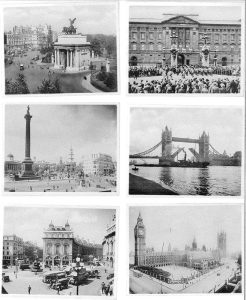

It is an intriguing glimpse into a world that has largely vanished. Colledge traveled abroad at an interesting time. He had coronation souvenirs from George VI’s coronation and extensively traveled Germany just after the 1936 Referendum took place which cemented the Nazi’s grip on power.
Momentos from the Olympics and casual tourist pamphlets are often stamped with the Nazi swastika which can be shocking to see. It was a brief moment before Germany and the rest of the world would be at war.
Scrapbooks are lush and creative in their own way. They vary widely: stylistically, in content, and in scope. Some scrapbooks are artistic, akin more to a personalized sketchbook, while others can belong to much larger groups such as social clubs or historical societies. Nonetheless, they all contain pieces of lives once lived, fragments of a time long past.
Written by Samantha Mooney
The DeKalb History Center’s Behind the Scenes series allow the general public to explore the museum’s collections & archives. For more content like this, please visit our post on the Infantry Flag and The Guy Hayes Collection


